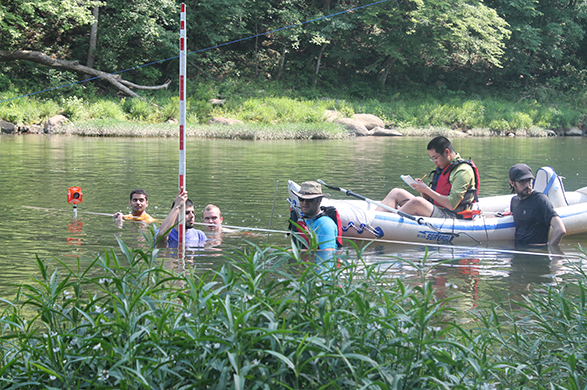
From the June 2015 Desktop News | Nearly 50 graduate students from across the globe have spent the last two weeks at The University of Alabama and at the Cahaba River learning about the tools and principles used in flood prediction as part of the National Flood Interoperability Experiment Summer Institute.
The institute is being hosted by the National Oceanic and Atmospheric Administration National Water Center, which is located on the UA campus. Four of the participating students are from UA’s Department of Geography, one is from UA’s Department of Civil, Construction and Environmental Engineering, and others represent 18 other universities from the United States, Sweden, China, Korea and the Netherlands.
The NFIE Summer Institute brings together graduate students to increase the accuracy, communication and available data for flood predictions across the nation. The seven-week program started with two weeks of boot camp, now completed, in which the students learned about the different computer models used in flood prevention and communication with first responders.
For the next five weeks, students will split into research teams and propose research plans. They will then present their results during an event coinciding with a conference hosted by the Consortium of Universities for the Advancement of Hydrologic Science on campus July 15-17.
Part of the two-week boot camp involved a field trip to the Cahaba River, where NFIE participants experienced river dynamics firsthand. Led by UA faculty and graduate students in UA’s Department of Geography, College of Engineering and the Environmental Institute, the participants literally got their feet wet by wading into the river, surveying the river channel and measuring river flow. The results of this intensive field campaign will be used to advance several NFIE research projects with the goal of better predicting flooding.
Dr. Sagy Cohen, resident faculty for NFIE and assistant professor of in the Department of Geography, said the faculty wanted to give the students a chance to go to a river because most of the work with NFIE will be on computers.
“We thought it would be good to take them to the field, to actually see a river, and literally get their feet wet,” Cohen said. “NFIE is not so much about boots on the ground research, but more about observation.”
Flooding is the most destructive natural disaster, Cohen said, as floods cause the most damage and death. While most people in Tuscaloosa understand the dangers when a tornado siren goes off, Cohen said there is not as much understanding when it comes to flooding, nor are there efficient warnings to effectively prevent catastrophes.
There are existing flood warning systems, but Cohen said they are very coarse. A flood warning may go out for all of Tuscaloosa County, but Cohen said the goal of NFIE is to have a system that can instead give a flood warning for specific streets.
In order to achieve their goals, students will take data from existing sources, add to computer models and help tie hydrology, hydraulics and emergency medical responders together.
Dr. Sarah Praskievicz, an assistant professor in the Department of Geography and a resident faculty member for NFIE, said they are looking at how much water exists in a certain area, and where the water flows to create a more encompassing survey that will help local emergency responders better respond to flooding.
“It makes a huge difference in how first responders and the public will respond to the risks,” Praskievicz said. “We’re trying to integrate all of these streams of data from different federal agencies that have, in the past, been separate so that we have the best resources to make forecasts.”
Both professors hope the students will depart with new skills and great experiences.
“This is the next generation of water scientists, and we’re hoping the relationships and collaborations they build at the summer institute will carry through their careers and beyond,” Praskievicz said.
When the students present their work on July 17, scientists from around the world will gather for the conference. Cohen said it will be a great opportunity for the students to show their work and make more connections. He also said they’re hoping to send a small group of students to brief the White House staff members on the findings within the next year.
Dr. Andrew Ernest, director of the Environmental Institute and professor of civil engineering, serves as senior principal investigator for the project and also contributed to the event.